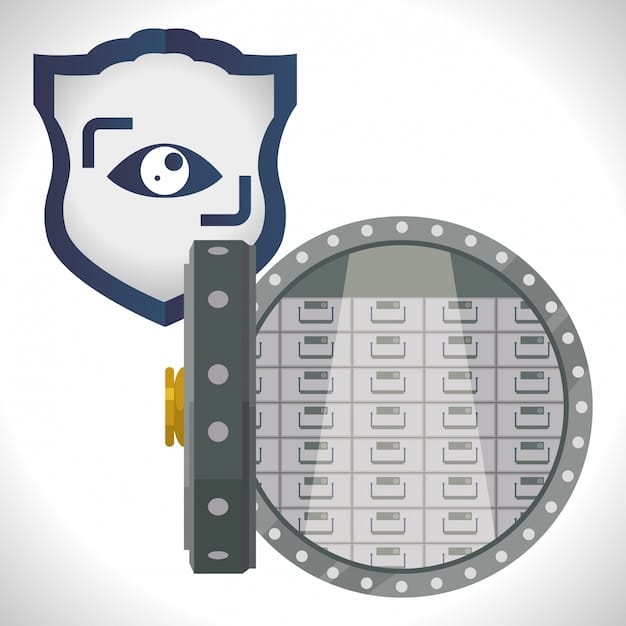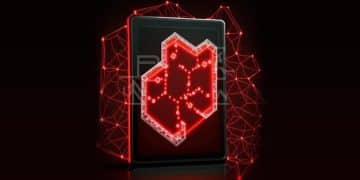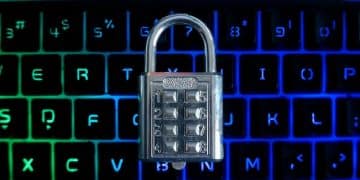Password Management Best Practices for Account Security

Strong password management practices are fundamental for protecting digital accounts and preventing data breaches by ensuring robust, unique credentials and secure storage mechanisms are consistently applied across all online activities.
In an increasingly interconnected digital world, safeguarding our online identities has become paramount. Effective password management: best practices to protect your accounts and prevent data breaches is not merely a technicality but a crucial defense against the ever-evolving landscape of cyber threats. Understanding and implementing these strategies can make all the difference in maintaining your digital security posture.
The foundational principles of strong passwords
The first line of defense in cybersecurity is always the password itself. Beyond simple length, a truly strong password incorporates a blend of characteristics designed to thwart automated attacks and brute-force attempts. It’s not just about what you choose, but how you construct and maintain it.
Modern security protocols emphasize entropy above all else. This means a password should be unpredictable, making it difficult for attackers to guess or crack, even with powerful computing resources. A password that relies on dictionary words, common phrases, or easily guessed personal information significantly reduces this entropy. Attackers often employ sophisticated tools that can rapidly test billions of common combinations. The seemingly random string of characters, numbers, and symbols is far more resilient.
Crafting truly complex passwords
Complexity is born from variety. A strong password leverages a mix of character types. This means including uppercase letters, lowercase letters, numbers, and special symbols. The longer the password, the exponentially more difficult it becomes to crack. A password of 8 characters might be cracked in hours, while a 16-character password with high entropy could take millennia. Many security experts now recommend passphrases – long sequences of unrelated words – as they can be both complex and easier for humans to remember. For example, “CorrectBatteryHorseStaple” is much stronger than “Pa$$w0rd123!”.
Avoiding common pitfalls
Users often fall into patterns that compromise their security. Reusing passwords across multiple accounts is one of the most dangerous habits. If one service is breached, all other accounts using the same password become vulnerable. Similarly, using easily identifiable personal information—like birth dates, pet names, or street addresses—makes passwords trivial to guess for anyone with basic knowledge of your life. It is also important to avoid sequential numbers or letters (e.g., “123456” or “abcde”). Regularly reviewing your passwords and eliminating any that fall into these categories is a critical step in enhancing your security. Thinking like an attacker can help you identify and rectify weak points in your password strategy.
A common misconception is that changing passwords frequently is the most effective strategy. While regular changes are good, the focus should be on the strength and uniqueness of the password, combined with multi-factor authentication. If you change a weak password for another weak password, the benefits are negligible. Instead, focus on creating robust passwords and maintaining their integrity.
The power of password managers
For many, the idea of remembering dozens, if not hundreds, of unique, complex passwords is daunting. This is where password managers become indispensable tools, offering a secure and efficient solution to a common cybersecurity challenge. A password manager is an application that stores and encrypts all your login credentials in a secure digital vault, accessible via a single master password.
These tools do more than just store information. They automate the process of creating strong, unique passwords for every new account you create. With a single click, you can generate a cryptographically strong password tailored to the complexity requirements of any website. This eliminates the temptation to reuse simple passwords or rely on easily guessable patterns. When you visit a website, the password manager can automatically fill in your credentials, saving time and preventing phishing attacks where you might accidentally type your password into a fake website.
Key features and benefits
- Secure encryption: Password managers use advanced encryption algorithms to protect your data, making it virtually impossible for unauthorized individuals to access your stored passwords. Even if an attacker gains access to your vault file, the encrypted data remains incomprehensible without your master password.
- Automatic generation of strong passwords: They create unique, complex passwords for each new account, adhering to best practices like length, character diversity, and randomness.
- Cross-device synchronization: Most modern password managers offer seamless synchronization across all your devices—laptops, smartphones, tablets—ensuring you have access to your passwords wherever you are.
- Secure sharing: Some managers allow the secure sharing of passwords with trusted individuals, which is particularly useful for shared accounts or team environments, without exposing the actual password.
- Audit features: Many offer security audits, identifying weak, reused, or compromised passwords, and guiding you to update them for improved protection.
- Two-factor authentication (2FA) integration: Many password managers include built-in 2FA capabilities or seamlessly integrate with external 2FA apps, adding an extra layer of security to your logins.
Choosing the right password manager
Selecting a password manager involves considering factors like security features, ease of use, cost, and cross-platform compatibility. Reputable options include LastPass, 1Password, Bitwarden, and Dashlane. Bitwarden, for example, is open-source and offers a robust free tier, making it a popular choice for budget-conscious users who still demand high security. 1Password is known for its user-friendly interface and extensive features, often favored by those looking for a premium experience. When making your choice, always ensure the provider has a strong track record of security and transparency. Read reviews and understand their privacy policies to ensure your data is handled responsibly.
The convenience offered by password managers cannot be overstated. By centralizing your login information in an encrypted vault, you reduce the cognitive load of remembering multiple credentials and significantly bolster your overall cybersecurity posture.
Implementing multi-factor authentication (MFA)
While strong passwords are a crucial first step, they are no longer sufficient on their own. Multi-factor authentication (MFA) adds an essential layer of security by requiring two or more verification methods to confirm a user’s identity before granting access to an account. This significantly complicates an attacker’s task, as compromising just one factor (like your password) is not enough to gain entry.
MFA leverages the concept of “something you know” (your password), “something you have” (a physical token, a smartphone), and “something you are” (biometrics like a fingerprint or face scan). By combining at least two of these factors, MFA creates a robust barrier against unauthorized access. For instance, even if a compromised database reveals your password, an attacker cannot log in without also possessing your smartphone or biometric data.
Types of MFA methods
There are several common methods for implementing MFA, each with its own advantages and considerations:
- SMS codes: A one-time passcode (OTP) is sent to your registered phone number. While convenient, SMS-based MFA is susceptible to SIM-swapping attacks.
- Authenticator apps: Apps like Google Authenticator or Microsoft Authenticator generate time-sensitive OTPs directly on your device. These are more secure than SMS codes as they are not tied to your phone number.
- Hardware security keys: USB devices like YubiKeys provide the highest level of security. They use cryptographic keys to verify your identity, making them resistant to phishing and sophisticated attacks.
- Biometrics: Fingerprint scans, facial recognition, and iris scans are convenient and increasingly common, especially on smartphones. They represent “something you are.”
- Email codes: Similar to SMS, a code is sent to your registered email. This method relies on the security of your email account.
Best practices for MFA deployment
Always enable MFA on every account that supports it, especially for critical services like email, banking, and cloud storage. Where possible, prioritize authenticator apps or hardware security keys over SMS or email codes for enhanced protection. Always have backup codes stored securely in case you lose access to your primary MFA device. Regularly review and update your MFA settings, ensuring your recovery options are current and secure. Many services now offer seamless MFA integration, making its setup straightforward.
Securely storing sensitive information
Beyond passwords, many individuals and businesses handle a variety of sensitive information online, from financial details to personal documents. Storing this data securely is just as critical as managing your passwords. Leaving sensitive files unprotected, whether on a local drive, cloud service, or external storage, creates significant vulnerabilities.
Unsecured data is a prime target for cybercriminals. If a device is lost or stolen, or if a cloud account is compromised, any unencrypted sensitive information can be immediately accessed and exploited. This could lead to financial fraud, identity theft, or severe privacy breaches. Therefore, implementing robust encryption and access controls is paramount.
Encryption: your digital shield
Encryption transforms data into an unreadable format, making it inaccessible to unauthorized parties. Even if an attacker gains access to encrypted files, they appear as a scrambled mess without the correct decryption key.
- Disk encryption: Tools like BitLocker (Windows), FileVault (macOS), or LUKS (Linux) encrypt entire hard drives, protecting all data stored on them. This is crucial for laptops and external drives.
- File/folder encryption: For specific sensitive documents, consider using dedicated file encryption software or features offered by secure cloud storage providers.
- Secure notes in password managers: Many password managers offer a “secure notes” feature, allowing you to store confidential text (e.g., software license keys, passport numbers) in an encrypted format alongside your passwords.
- Encrypted messaging: Use applications that offer end-to-end encryption for sensitive communications, ensuring that only the sender and intended recipient can read the messages.
Access control and secure habits
Encryption is powerful, but it must be complemented by strong access control and diligent habits. Never share encryption keys or master passwords. Use strong, unique passwords for any encrypted containers or devices. Implement strict folder permissions on shared drives, limiting access only to those who genuinely require it. Regularly review who has access to your sensitive files and remove outdated permissions.
For cloud storage, ensure you use reputable providers with strong security protocols and enable MFA on your cloud accounts. Be wary of public Wi-Fi networks when accessing or transferring sensitive information, as they can be easily intercepted. Finally, always back up encrypted data to a separate, secure location, ensuring you don’t lose access in case of device failure while maintaining confidentiality.

Recognizing and avoiding phishing attacks
Phishing remains one of the most prevalent and effective methods cybercriminals use to compromise accounts. Despite widespread warnings, its sophistication continues to evolve, making it challenging for even vigilant users to identify. Phishing relies on deception, impersonating trusted entities to trick individuals into divulging sensitive information such as usernames, passwords, credit card details, or even personal identifiable information (PII).
These attacks often come in the form of emails, text messages (smishing), or phone calls (vishing) that appear legitimate. They might mimic banks, popular social media platforms, e-commerce sites, government agencies, or even colleagues and superiors. The common thread is an urgent call to action, often involving a perceived problem with an account, an appealing offer, or a threat of legal action, all designed to induce immediate, unthinking compliance.
Telltale signs of a phishing attempt
While phishing attacks are becoming more sophisticated, several red flags can help you identify them:
- Suspicious sender’s address: Check the “from” address carefully. It might look similar but often has subtle misspellings or an unusual domain name (e.g., “[email protected]” instead of “[email protected]”).
- Generic greetings: Legitimate organizations usually address you by name. Generic greetings like “Dear Customer” can be a sign of a mass phishing campaign.
- Urgent or threatening language: Phishers often create a sense of urgency (“Your account will be suspended!”) or fear (“Immediate action required!”) to bypass critical thinking.
- Requests for sensitive information: Legitimate entities will rarely ask for your password, SSN, or full credit card number via email or text. Never provide this information.
- Misspellings and bad grammar: Professional organizations thoroughly proofread their communications. Many phishing emails, especially from less sophisticated actors, contain grammatical errors or typos.
- Suspicious links: Hover over links (without clicking!) to see the actual URL. If it directs to an unfamiliar domain, it’s likely a phishing attempt. Be especially wary of shortened URLs.
- Unexpected attachments: Never open unexpected attachments, especially those with unusual file types (.exe, .zip, .js), as they often contain malware.
Strategies for protection
The most effective defense against phishing is education and vigilance. Always verify the authenticity of suspicious requests by contacting the organization directly through official channels (e.g., their official website, not links in the email). Use multi-factor authentication whenever possible, as it adds a layer of protection even if your password is compromised. Regularly update your browser, operating system, and antivirus software to patch known vulnerabilities. Report phishing attempts to your email provider and relevant authorities to help protect others. Remember, when in doubt, it’s always safer to err on the side of caution.
Regular security audits and updates
Cybersecurity is not a static state; it’s a continuous process. The digital threat landscape is constantly evolving, with new vulnerabilities discovered daily and more sophisticated attack techniques emerging. Consequently, regular security audits and timely software updates are indispensable components of any robust password management and overall cybersecurity strategy. Neglecting these practices leaves significant backdoors open for opportunistic attackers.
Software developers constantly release updates that include security patches for newly discovered flaws. These vulnerabilities, if left unpatched, can be exploited by attackers to gain unauthorized access to your systems, inject malware, or steal data. An unpatched system is like leaving your front door unlocked in a bustling city.
The importance of systematic updates
The proliferation of software across devices—from operating systems and web browsers to applications and firmware—means a multitude of potential entry points for attackers. Regular updates address these vulnerabilities proactively.
- Operating System (OS) updates: Windows, macOS, Linux, Android, iOS. These updates often contain critical security fixes. Enable automatic updates where possible.
- Browser updates: Chrome, Firefox, Edge, Safari. Browsers are frequent targets, and keeping them updated protects against web-based exploits.
- Software applications: Antivirus software, productivity suites, media players—any application interacting with external data can be a vector. Update them regularly.
- Firmware updates: Routers, modems, smart home devices, IoT gadgets. These devices often have vulnerabilities that can allow network intrusions if their firmware isn’t kept current.
Conducting security audits
Beyond just updating, a periodic security audit of your digital ecosystem is crucial. This involves actively reviewing your current security posture:
* Password audit: As mentioned, use your password manager’s audit feature to identify weak, reused, or compromised passwords. Prioritize changing these immediately.
* Account review: Regularly review all your online accounts. Close old accounts that you no longer use, as they represent unnecessary attack surfaces.
* MFA review: Ensure MFA is enabled on all critical accounts and that your recovery options are up-to-date and securely stored.
* Device security: Check firewall settings, antivirus scans, and ensure your devices are protected with strong passwords or biometrics.
* Privacy settings: Review privacy settings on social media and other online services to limit the exposure of personal information.
By integrating these regular reviews and proactive updates into your routine, you significantly reduce your attack surface and stay ahead of emerging threats, bolstering the overall effectiveness of your password management strategy.

Educating yourself and staying informed
In the dynamic world of cybersecurity, knowledge is power. The landscape of threats and defenses shifts continuously, rendering static security practices inadequate. Continuous education and staying informed about the latest cyber threats, best practices, and technological advancements are arguably the most critical components of effective security, particularly in password management: best practices to protect your accounts and prevent data breaches.
The adversaries are always learning. Cybercriminals constantly refine their techniques, exploiting new vulnerabilities and leveraging social engineering tactics. For individuals and organizations alike, staying current means anticipating these shifts rather than reacting to them after a breach occurs. This proactive approach minimizes risk and enhances resilience.
Reliable sources of cybersecurity information
Discerning reliable information from misinformation is vital. Look for sources that are reputable, objective, and provide evidence-based insights.
- Official government agencies: Organizations like the Cybersecurity and Infrastructure Security Agency (CISA) in the US, or the National Cyber Security Centre (NCSC) in the UK, offer official advisories and guidelines.
- Reputable cybersecurity news outlets: Websites and publications dedicated to cybersecurity news like KrebsOnSecurity, The Hacker News, orZDNet’s security section provide timely updates and analyses.
- Security blogs and podcasts: Many security researchers and firms maintain blogs and podcasts (e.g., SANS Internet Storm Center, Darknet Diaries) that offer in-depth discussions.
- Academic research and conferences: Papers from cybersecurity conferences (e.g., Black Hat, Def Con) often present cutting-edge research on threats and defenses.
- Software vendors’ security advisories: Companies like Microsoft, Apple, Google, and major antivirus providers regularly publish security bulletins and best practice guides.
Practical steps for continuous learning
Integrate learning into your routine. Subscribe to newsletters from reputable cybersecurity sources. Follow cybersecurity experts on professional platforms like LinkedIn or X (formerly Twitter). Attend webinars or online courses on cybersecurity fundamentals. Even spending 15-20 minutes a week reading up on recent breaches and security tips can significantly boost your awareness. Understand current attack vectors, common vulnerabilities, and the latest defense mechanisms. This ongoing commitment to learning not only protects your digital assets but also empowers you to make informed decisions about your online interactions, reinforcing the principles of effective password management and broader digital safety.
| Key Practice | Brief Description |
|---|---|
| 🔑 Strong Passwords | Use unique, long, and complex passwords or passphrases for all accounts to maximize unpredictability. |
| 🛡️ Password Managers | Employ a trusted application to securely generate, store, and manage all your login credentials. |
| ✅ Multi-Factor Authentication | Enable MFA on all possible accounts for an extra layer of security beyond just a password. |
| vigilant against Phishing | Learn to identify and avoid deceptive attempts to trick you into revealing sensitive information. |
Frequently asked questions about password management
Strong, unique passwords are critical because they form the primary defense against unauthorized access. If you reuse passwords and one account is breached, all other accounts using that same password become instantly vulnerable. Unique, complex passwords significantly increase the effort required for attackers to guess or crack them, thus protecting your digital identity and data from compromise across various platforms.
A password manager is a secure application that stores all your login credentials in an encrypted vault, accessible via a single master password. You should use one because it generates and remembers unique, complex passwords for every account, eliminating the need for you to recall them. This drastically improves your security posture by preventing password reuse and simplifying secure access to all your online services.
MFA enhances security by requiring at least two different forms of verification (e.g., something you know like a password, and something you have like a phone or key) to log in. This means that even if an attacker manages to steal your password, they cannot access your account without the second factor. MFA acts as a robust secondary barrier, significantly reducing the risk of unauthorized access.
Common signs of a phishing attempt include suspicious sender email addresses, generic greetings instead of your name, urgent or threatening language, requests for sensitive personal information, unexpected attachments, and links pointing to unfamiliar domains. Always verify the sender and the legitimacy of the request through official channels before clicking links or providing information, protecting yourself from cyber scams.
Regularly updating software and conducting security audits are crucial because cyber threats evolve constantly. Updates provide critical security patches for newly discovered vulnerabilities, preventing attackers from exploiting known flaws. Audits help identify weak passwords, unused accounts, and outdated security settings, ensuring your defenses remain robust and current against the ever-changing landscape of cyber threats, maintaining your digital integrity.
Conclusion
The digital world demands a proactive and informed approach to cybersecurity. While the sheer volume of online threats might seem daunting, adopting the best practices in password management significantly empowers individuals and organizations to protect their valuable digital assets. From crafting robust, unique passwords and leveraging the indispensable efficiency of password managers to implementing multi-factor authentication and staying vigilant against sophisticated phishing attempts, each step reinforces a comprehensive defense strategy. Continuous education and regular security audits are not merely good advice but essential disciplines in an ever-evolving threat landscape. By embracing these principles, we can navigate the complexities of the internet with greater confidence, ensuring our accounts remain secure and our personal information stays private. The investment in these practices is an investment in digital peace of mind.





